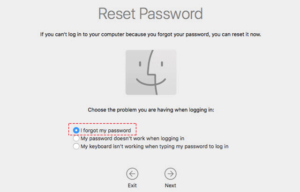

This is because your Keychain password is typically the same as your Mac user password, but since you’ve reset it, the passwords no longer match.

Remember, you will lose access to your old Keychain data and won’t be able to unlock your login Keychain. That’s how you can reset a Mac’s password without having to rely on using an Apple ID. You’ll be prompted to reboot your Mac and once it restarts, you can log in with the new password. Type in your new preferred password, choose a hint, and then click “Next”.

This will launch the Recovery Assistant where you’ll be able to reset your Mac’s user password.Once Terminal opens up, type “resetpassword” without the quotes and hit the Return key.Pull down the Utilities menu option, then choose “Terminal” from the dropdown menu, as shown in the screenshot below.On ARM Macs: after reboot immediately hold down the Power button to access Recovery Mode, then choose “Options”.On Intel Macs: As soon as the screen turns back on, start holding Command + R keys to boot your Mac into Recovery mode.If you’re stuck in the login screen, you’ll find the restart option right below the password field.



 0 kommentar(er)
0 kommentar(er)
